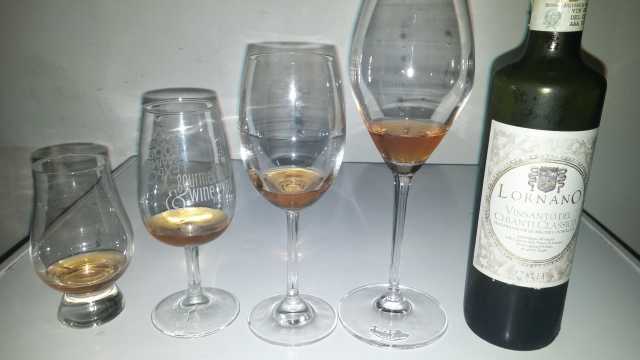John - the shape of the glass has pretty much nothing to do with the way the wine is delivered to your mouth. Take any number of glasses and partly fill them with water. Hold them over the sink and pour the water out. It goes in one direction - down.
And even if it made a difference, do you just gulp the wine down? Or do you let it linger in your mouth for a few seconds to taste it? All that is marketing myth that Reidel has now dropped.
By implication, this would seem to support what I’ve always believed: that the glass, apart from influencing the aroma of a wine before it gets into your mouth, doesn’t have any impact on the actual taste of a wine.
This is not by implication, it is simply correct. But let’s define “taste”.
Look at the way we obtain and process taste and aroma information.
Dogs and other animals have long nasal passages. Within those passages are many more receptor cells than humans have in our noses. The passages warm the air, humidify it, and pick up additional information from the volatile compounds the animal is sniffing.
From rodents to primates to humans, there is a decline in the number of functional olfactory receptor genes as vision became our dominant source of information. Mice and rats have about three times as many as humans do. But when they do experiments, over 80% of the olfactory system in an animal can be removed with no apparent decline in sensitivity. So apparently a lot of it is redundant, or more likely, we just don’t know what’s really happening because we can’t talk to rats.
Interestingly, humans do very well in picking up scents, often as well as dogs and rodents for some compounds. So what is happening?
From the nose, the information goes to the olfactory bulb, which in most animals is much larger in proportion to the rest of the brain than it is in humans, and is towards the front of the brain. Information goes to the olfactory bulb and from there to other regions of the brain.
And that’s it. They get a lot of information in. By smell, a rat can distinguish a worm that’s been dead for several days from one that’s been dead only a few days. A bloodhound can find faint traces of a person who’s passed by a few days earlier.
Taste isn’t a big concern to a dog or a rat. A dog doesn’t bother much with what it’s eating – it just swallows whole chunks of food. Consequently they have a fraction of the taste buds that humans do.
But far more important is the human brain. We do take in smells through our noses like dogs do – that’s called orthonasal perception. And wine people who don’t know much more than that will claim that taste is mostly smell so the aroma of a wine is the most important aspect of it to them. Weird way to enjoy wine – pretending you’re a dog.
In fact, most of what we pick up does NOT come from orthonasal perception, it comes from retronasal perception. To some degree, our mouths act like the nasal passage of a dog – that’s where food and drink are warmed and humidified and where additional information is picked up. The “smell” goes to our nose from our throat and we perceive it as coming from within ourselves, like we tastes of sweetness or sourness and our brains combine the smell with the taste and we call it “flavor”. In other words, whether the information comes from our tongue or from our retronasal passage doesn’t matter – our brain process it as if it’s all part of a piece.
Some of the information does in fact go to our olfactory bulb just like it does with any other animal. But our olfactory bulb is lower and deeper in our brains, not towards the front. From the olfactory bulb the information goes to other parts of the brain, including the frontal lobe, which surpasses that of any other animal, connecting to memories, motivation, judgment, and even emotion from the limbic system. More interestingly, some of the neurons simply bypass the olfactory bulb altogether and go directly to the cortex, some directly to our emotional centers.
So flavor must have been an important part of our lives, or we wouldn’t have developed such direct connections. Moreover, as the different parts of our brains light up, they create unique patterns. Our brains have one pattern for a cherry, another for shrimp - odor images as it were. Those patterns are exactly like the patterns created by information processed by sight. In other words, we can recognize particular flavors just like we can recognize a friend across a football field. That is why people who sometimes say that blind tasting is a parlor trick don’t know what they’re talking about – it’s simply pattern recognition, something the human brain is particularly good at.
And interestingly, our ability to speak adds another dimension. It’s hard cognitive work to describe exactly what it is we are experiencing - it’s what we are uniquely adapted to.
Now as to whether a wine tastes the same through a straw or from a glass – do an experiment. Take some soda or juice and pour it into a glass. Drink some and then taste some through a straw. Does it taste different? Humans are remarkably good at picking up differences – it’s pattern recognition remember. If the Coke tasted different depending on the delivery mechanism, Coke would not be pleased. Their whole point is to make something that tastes the same all the time. Of course, Reidel, with their BS machine in overdrive, has created a special glass for Coke.
So no, the glass doesn’t matter in the least insofar as delivering the information to your receptors. People should stop trying to claim that it does.
However, in one respect, and it’s the only one, Reidel has a point. Humans seem to enjoy their food far more than any other animal. That’s because of the incredible connections between the different parts of our brain. Food has an emotional component for humans that it seems to lack for other creatures, at least insofar as science can determine. And it’s that last component – the emotional component, that gives Reidel some claim. It’s impossible for humans to separate emotion from eating and from flavor. Our nervous system is hard-wired to connect the two. So if glass A makes something seem better to you than glass B, OK.
(Sorry for the long post.)

